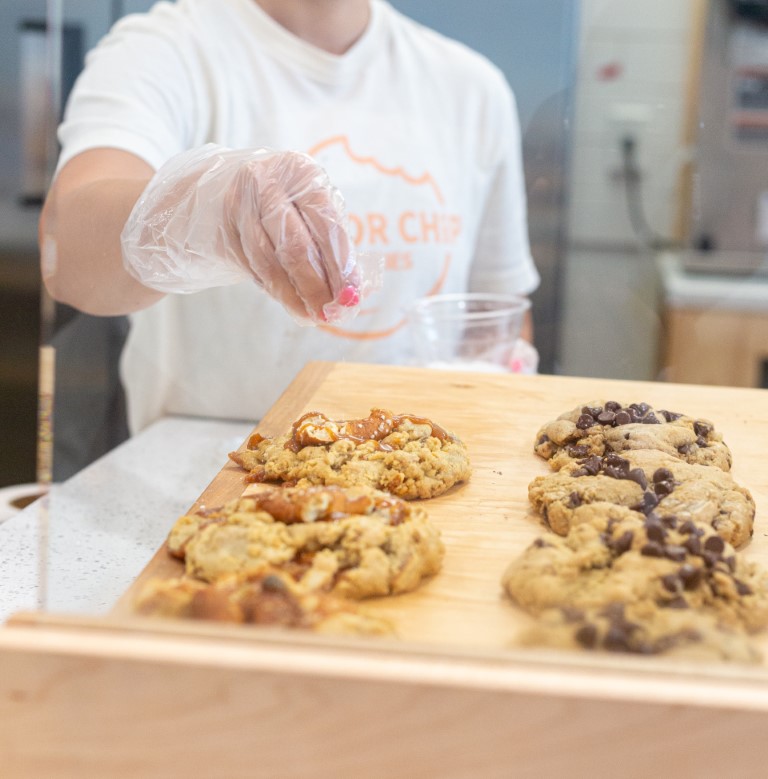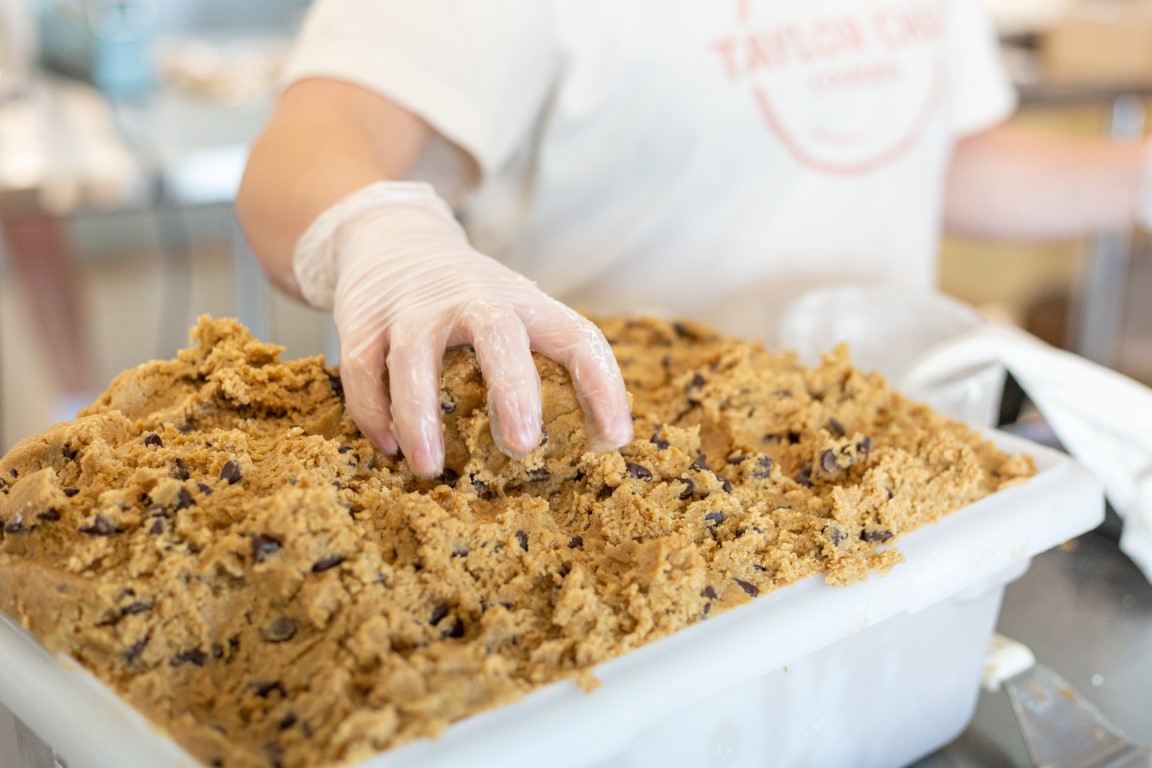If the cookie dough left out overnight, it becomes highly susceptible to bacterial growth, increasing your risk of foodborne illness. Pathogenic bacteria like Salmonella and E. coli can thrive at room temperature, and their toxins may persist even after baking. To maintain safety and dough quality, always refrigerate it below 40°F. Proper storage in an airtight container or plastic wrap prevents moisture loss, keeps the dough fresh, and guarantees better baking results. Adhering to these guidelines assures cookies that are both safe to eat and delicious. Learn more about proper handling to guarantee your baking is always up to standard.
Key Takeaways
- Leaving cookie dough out overnight can lead to bacterial growth, increasing foodborne illness risk.
- Room temperature promotes proliferation of harmful bacteria like Salmonella and E. coli in cookie dough.
- Dough left out may develop toxins from bacteria that persist even after baking.
- Excessive room exposure causes dough to soften, affecting shape and texture during baking.
- Always refrigerate cookie dough promptly to ensure safety and maintain quality.
Importance of Cookie Dough Handling
Proper handling of cookie dough is essential to guarantee both the safety and quality of your baked goods. When dealing with cookie dough, you must be vigilant about food safety to prevent bacterial growth. Harmful bacteria, such as Salmonella and E. coli, can thrive in dough that's improperly stored. Always keep your cookie dough refrigerated to minimize the risk of bacterial contamination.
If you're making a batch of refrigerated chocolate chip cookies, make certain the dough stays cool until you're ready to bake. Leaving cookie dough out at room temperature for extended periods allows harmful bacteria to multiply rapidly, posing a considerable health risk. It's not just about keeping your cookies tasty; it's about preventing foodborne illnesses.
To maintain the integrity of your cookie dough, store it in an airtight container in the refrigerator. This practice not only slows down bacterial growth but also keeps the dough from drying out, making sure your cookies bake up perfectly. Remember, proper cookie dough handling isn't just a recommendation; it's a necessity for delicious and safe baked goods. Following these guidelines guarantees that every bite is both enjoyable and safe for everyone.

Choose Your Own Delightfully Perfect Cookies.
With almost 30 flavors to choose from, you can make your box as unique as you are.
The Science of Cookie Dough
Understanding the science of cookie dough starts with knowing its composition and properties. Different ingredients in the dough, such as flour, sugar, and fats, interact in specific ways to affect texture, flavor, and overall quality. By examining how these components work together, you'll gain insight into why proper handling is essential.
Composition and Properties
Cookie dough is a captivating blend of ingredients that each play an essential role in the final product's texture, flavor, and structure. When you examine the composition and properties of raw cookie dough, you'll notice that it comprises both wet and dry ingredients. Key components include flour, sugar, eggs, and butter cold from the refrigerator. Each ingredient contributes uniquely to the dough's behavior and qualities.
Butter, for instance, should be used cold to maintain the dough's structure and control the spread when baked. The internal temperature of the dough can greatly impact its consistency; warmer dough can become too soft, making it difficult to shape and handle. The dry ingredients, such as flour and sugar, provide the necessary bulk and sweetness, respectively. Flour forms the gluten network, which gives the dough its elasticity and chewiness, while sugar affects sweetness, browning, and crispness.
Understanding the properties of raw cookie dough helps you predict how it will behave during baking. For example, the way butter and sugar interact with each other and with the flour determines the final texture of your cookies. Mastering these aspects allows for better control over the baking process and the quality of your cookies.
Impact of Ingredients on Dough Quality
When crafting cookie dough, each ingredient's role is vital to the dough's overall quality and performance. The balance among flour, sugar, butter, and eggs determines texture, flavor, and how the dough behaves during baking.
To explore the impact of ingredients, consider these key points:
-
Butter: Using cold butter helps create a firmer dough, fundamental for chilled cookie dough, which prevents spreading too much on the baking sheet. Softened butter, however, incorporates more air, making cookies lighter.
-
Sugar: The type of sugar you choose affects the dough's moisture and texture. Brown sugar adds moisture and chewiness, while granulated sugar leads to a crisper cookie. This can be observed in the dough before baking and after overnight refrigeration.
-
Eggs: Eggs contribute to the dough's structure and moisture content. More eggs result in a cakier texture, while fewer eggs make the dough denser and chewier.
Maintaining proper fridge temp during overnight refrigeration is essential. Chilling dough firms the fats, leading to less spread and more defined edges. Always refrigerate the dough before baking to enhance flavor and texture. These factors guarantee your cookies turn out just right, every time.
Risks of Leaving Cookie Dough Out Overnight
Leaving cookie dough out overnight poses important risks, including microbial growth and food safety concerns, which can lead to foodborne illnesses. Additionally, the dough's quality and texture might change, affecting the final baked product.
It's essential to understand these risks to make informed decisions about food preparation and storage.
Microbial Growth and Food Safety Concerns
Your kitchen's warm environment can become a breeding ground for bacteria when cookie dough is left out overnight. This is especially concerning because raw dough contains perishable food items like eggs and dairy, which are highly susceptible to microbial growth. When exposed to room temperature for extended periods, the risk of food poisoning increases considerably.
Leaving cookie dough out overnight presents several food safety risks:
- Pathogenic Bacteria: Harmful bacteria such as Salmonella and E. coli can proliferate in raw dough, leading to serious foodborne illnesses if ingested.
- Toxin Production: Some bacteria can produce toxins that are not destroyed by baking, posing a continued health risk even after cooking.
- Cross-Contamination: If other foods or utensils come into contact with the contaminated dough, the risk of spreading bacteria increases.
To maintain food safety, always refrigerate dough promptly. The USDA recommends keeping perishable foods, including raw dough, at or below 40°F to inhibit microbial growth.
Understanding these risks helps you make informed decisions about food storage, considerably reducing the chance of food poisoning. By being vigilant, you protect your health and the well-being of those who might enjoy your baked goods.
Changes in Dough Quality and Texture
Although it might seem harmless, letting cookie dough sit out overnight can greatly alter its quality and texture. When you leave dough exposed to room temperature, the cookie dough formulation begins to change.
The fats in the dough can soften too much, making it difficult to properly shape the cookies later. This can lead to cookies that spread too much on the baking sheet, resulting in a thinner, less appealing cookie texture.
Additionally, the temperature dough is exposed to plays an essential role in its consistency. Dough left out overnight can absorb moisture from the air, leading to an overly sticky and difficult-to-handle mixture. In contrast, keeping dough in the fridge maintains its structure, ensuring that it's easier to work with and produces a consistent bake.
Moreover, the longer cookie dough sits out, the higher the chance of bad bacteria developing. Not only does this pose a health risk, but it can also affect the taste and texture of your cookies.
To summarize, while it might seem convenient to leave cookie dough out overnight, the changes in dough quality and texture, along with potential bacterial growth, make it a risk not worth taking.
Best Practices for Cookie Dough Storage
To keep your cookie dough fresh and flavorful, it's essential to understand both short-term and long-term storage options. For short-term storage, placing the dough in an airtight container in the refrigerator can help maintain its quality for a few days.
For long-term storage, freezing the dough not only preserves it for months but also enhances its flavor as it ages.
Short-Term and Long-Term Storage Solutions
Storing cookie dough properly is crucial to maintaining its freshness and flavor. Whether you need a short-term or long-term solution, there are key best practices to follow to guarantee your dough remains safe and delicious.
Short-Term Storage
- Use an airtight container: Immediately after preparing the dough, place it in an airtight container. This prevents exposure to air, which can dry out the dough and affect its texture and taste.
- Wrap in plastic wrap: If you don't have an airtight container, plastic wrap is a good alternative. Wrap the dough tightly, making sure no air pockets are left, and then place it in the refrigerator.
- Form cookie dough balls: For added convenience and food safety assurance, pre-portion your dough into cookie dough balls before storing. This makes it easier to bake later and helps maintain uniformity.
Long-Term Storage
- Freeze the dough: To store dough for extended periods, freezing is your finest option. Form the dough into balls, place them on a baking sheet to freeze, then transfer to a freezer-safe bag.
- Double-wrap for extra protection: When freezing, double-wrap the dough in plastic wrap before placing it in the airtight container or freezer bag. This provides an additional barrier against freezer burn.
- Label and date: Always label and date your frozen dough so you know how long it has been stored, assuring you use it within three months for peak quality.
Flavor Development Through Aging
You might be surprised to learn that allowing your cookie dough to age can considerably boost its flavor. When you refrigerate cookie dough for several days, the flavor of cookies improves due to a variety of chemical reactions that occur over time. By letting the dough rest in the cold, ingredients like flour and sugar have a chance to fully hydrate and meld together, resulting in a richer, more developed cookie flavor.
To maximize this flavor development, store your cookie dough in an airtight container in the refrigerator for at least 24 to 72 hours. This period allows the dough to mature, leading to an enhanced taste profile. Cold dough also tends to spread less during baking, which can result in cookies with a better texture and more defined shape.
Additionally, the extended refrigeration time helps the dough's fat content solidify, which can positively impact the baking time. When you finally bake the aged dough, you'll notice that the cookies often bake more evenly and achieve a delightful balance of crisp edges and chewy centers. By incorporating these practices, you'll uplift the flavor of your cookies and produce consistently delicious results.
Alternatives and Innovations in Cookie Dough
Exploring alternatives and innovations in cookie dough, you'll find gluten-free and health-conscious options that cater to various dietary needs, ensuring everyone can enjoy this treat. Innovative ingredients and techniques, such as using chickpea flour or avocado, offer new textures and flavors, transforming the traditional cookie dough experience. Additionally, cultural variations in cookie recipes introduce diverse and unique takes on this beloved dessert, broadening your culinary horizons.
Gluten-Free and Health-Conscious Options
Embracing the health-conscious trend, many cookie dough enthusiasts are turning toward gluten-free and nutritious alternatives that don't compromise on taste. In order to meet these demands, you can create homemade cookie dough using high-quality ingredients that comply with stringent food laws.
Here are three key points to keep in mind when exploring gluten-free and health-conscious cookie dough options:
-
Gluten-Free Flours: Replace traditional wheat flour with almond, coconut, or oat flour. These alternatives not only cater to gluten-free diets but also add unique flavors and textures to your dough.
-
Natural Sweeteners: Opt for natural sweeteners like honey, maple syrup, or coconut sugar to reduce refined sugar intake. These options offer a healthier sweetness that aligns with a health-conscious lifestyle.
-
High-Quality Ingredients: Focus on incorporating high-quality, organic ingredients to enhance the nutritional value of your cookie dough. Ingredients like dark chocolate chips, chia seeds, and unsweetened cocoa powder can boost the health benefits without sacrificing taste.
Innovative Ingredients and Techniques
As the demand for gluten-free and health-conscious cookie dough options continues to rise, the exploration of innovative ingredients and techniques becomes imperative. One way to improve your cookie dough is by experimenting with alternatives like almond flour or coconut sugar, which not only enhance flavor but also make the dough firmer. This increased firmness can help maintain texture, especially when dealing with gluten-free recipes.
Another critical factor to evaluate is water activity. By reducing the water content in the dough, you can extend its fridge life and prevent microbial growth. Ingredients like honey or agave syrup can be used to sweeten the dough while lowering water activity. To further preserve your dough, always store it in an airtight freezer container. This will prevent moisture loss and keep it fresh for longer periods.
Innovative ingredients such as chia seeds or flaxseeds can also be incorporated to add nutritional value and improve texture. These seeds absorb moisture, making the dough firmer and easier to handle. By focusing on these advanced techniques, you can create cookie dough that not only meets health standards but also tastes delicious and maintains its quality over time.
Cultural Variations in Cookie Recipes
The richness of cultural diversity shines brightly in cookie recipes from around the world. Different nations have their own unique cookie dough types and traditions, creating a vast array of cookie dough varieties. Exploring these types of cookies can enrich your baking repertoire and introduce you to new flavors and textures.
Consider these three fascinating cultural cookie recipes:
-
Italian Biscotti: These twice-baked cookies are known for their crisp texture and are often enjoyed with coffee. The dough typically includes almonds, anise, or other nuts and spices, offering a delightful crunch.
-
French Macarons: These delicate, colorful cookies made from almond flour and meringue are sandwiched together with ganache or buttercream. The cookie dough varieties here differ greatly from traditional American cookies, requiring precise techniques and patience.
-
Mexican Polvorones: Also known as Mexican wedding cookies, these crumbly, buttery delights are made from a simple dough of flour, powdered sugar, and nuts. Rolled in additional powdered sugar after baking, they melt in your mouth.
Each of these homemade cookies showcases how diverse ingredients and techniques can create unique and delicious results. By experimenting with different cookie recipes, you can appreciate the rich fabric of global baking traditions.
Why Trust Our Cookie Crafting Insights?
At Taylor Chip, our journey into the world of cookie perfection began as a labor of love. Since 2015, Sara and Dougie Taylor have been honing their baking skills, transforming from enthusiastic amateurs to dedicated cookie artisans. Their passion for sweets and commitment to excellence led them to spend countless hours experimenting with recipes, techniques, and ingredients, ultimately achieving what they consider the perfect cookie.
This hands-on experience has given us a deep understanding of the intricacies of cookie dough preparation, storage, and baking. We've encountered and overcome the challenges that many home bakers face, from ingredient interactions to storage dilemmas. Our expertise isn't just theoretical; it's born from years of practical application, trial and error, and a genuine love for the craft. When we share insights about cookie dough handling, food safety, or flavor development, we're drawing from a well of personal experience and dedicated study.
Our commitment to quality and safety in cookie making extends beyond our own kitchen. We understand the importance of sharing accurate, reliable information with our community of bakers. That's why we've taken the time to research and incorporate food safety guidelines and best practices into our baking process and the advice we offer. When you read our insights on cookie dough storage, ingredient selection, or baking techniques, you can trust that you're getting advice from passionate bakers who have made it their mission to perfect the art of cookie making.
Frequently Asked Questions
Can I Still Bake Cookies if the Dough Was Left Out Overnight?
If you left the dough out overnight, it's not safe to use. Bacteria can grow quickly at room temperature. It's best to discard the dough and make a fresh batch to guarantee your cookies are safe to eat.
How Can I Tell if My Cookie Dough Has Gone Bad?
You can tell if your cookie dough has gone bad by checking for an off smell, discoloration, or mold. If the dough feels excessively sticky or has a sour taste, it's best to discard it.
Is Refrigerated Cookie Dough Healthier Than Dough Left at Room Temperature?
Refrigerated cookie dough is generally healthier because it slows bacterial growth, preserving ingredients better. Dough left at room temperature can spoil quickly, leading to potential foodborne illness. Always refrigerate to guarantee your dough stays safe and fresh.
Can I Freeze Cookie Dough to Extend Its Shelf Life?
You can definitely freeze cookie dough to extend its shelf life. Just wrap it tightly in plastic wrap or place it in an airtight container. When you're ready to bake, thaw it in the fridge overnight.
Are There Any Signs of Spoilage I Should Look for in Cookie Dough?
You should watch for changes in color, texture, and smell. If the dough turns darker, becomes slimy, or emits a sour or off-putting odor, it's likely spoiled. Always trust your senses to guarantee safety.
Conclusion
In conclusion, handling cookie dough properly is essential to avoid potential health risks. Leaving it out overnight can lead to bacterial growth, compromising both safety and flavor. To keep your cookie dough fresh, always store it in the refrigerator or freezer, ensuring it's tightly sealed. By following best practices for storage and exploring innovative alternatives like edible cookie dough, you can enjoy delicious and safe treats without worry.










